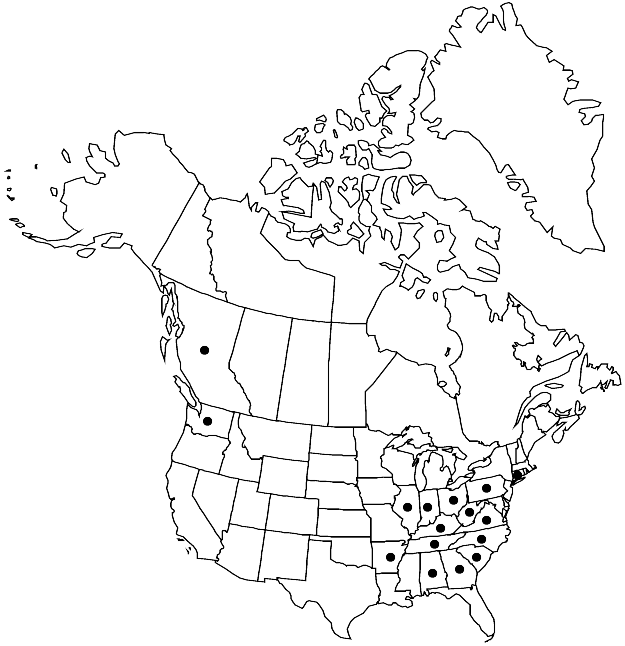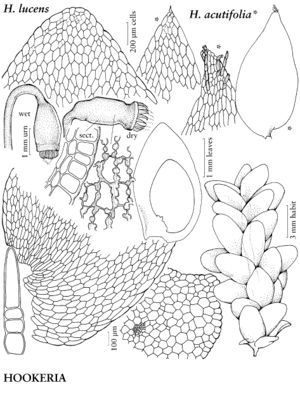Hookeria acutifolia
Edinburgh J. Sci. 2: 225, plate 5 [upper left]. 1825.
Leaves with acute apex; laminal cells (except rhizoid initials at apex) ± homogeneous; marginal cells narrower than medial cells. Capsule not or little contracted below mouth when dry.
Phenology: Capsules mature late fall–spring.
Habitat: Steep to vertical banks, crevices and recesses in cold streams, gullies, ravines, mouths of caves, ledges, under overhanging cliffs, deep shade of evergreen and mixed hardwood forests, by waterfalls, gneiss, shale, conglomerates, on sandstone, in coves, low cloud forests, with Bryoxiphium, Trichomanes, Vittaria spp.
Elevation: moderate to high elevations (500-2500 m)
Distribution

B.C., Ala., Ark., Conn., Ga., Ill., Ind., Ky., N.C., Ohio, Pa., S.C., Tenn., Va., Wash., W.Va., s Mexico, West Indies, Central America, South America, e Asia, Africa, Pacific Islands (Hawaii).
Discussion
Hookeria acutifolia is a species of warm-temperate and tropical distribution, rare and scattered in eastern North America, and disjunct to British Columbia and Washington state. The leaves may be more lanceolate (broadest below the middle) than those of H. lucens. The oceanic habitat appears conducive to fruiting in this species. A. J. Grout (1934b) indicated that spores were rarely produced in winter.
In Hookeria acutifolia, when the leaf apex lacks rhizoids, the apex is sharply acute and tipped with a small sharp apical cell; when rhizoids are present, the apical cells are digested and the apex becomes erose and bluntly rounded-acute, but never smoothly rounded-obtuse as in H. lucens. Hookeria acutifolia was reported as autoicous in Mexico (F. D. Bowers 1994), eastern North America (H. A. Crum and L. E. Anderson 1981), England (A. J. E. Smith 1978), and China (Lin B. J. and B. C. Tan 2002). A. J. Grout (1934b) described the sexual condition of the species as dioicous, and E. Lawton (1971) described specimens from the Pacific Northwest as having perichaetia and gemmiform perigonia on separate plants. Fruiting plants seen from British Columbia were autoicous; however, many separate plants in the same collection had only male buds.
Selected References
None.
